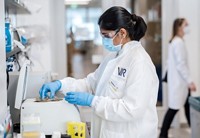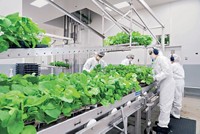Advertisement
Grab your lab coat. Let's get started
Welcome!
Welcome!
Create an account below to get 6 C&EN articles per month, receive newsletters and more - all free.
It seems this is your first time logging in online. Please enter the following information to continue.
As an ACS member you automatically get access to this site. All we need is few more details to create your reading experience.
Not you? Sign in with a different account.
Not you? Sign in with a different account.
ERROR 1
ERROR 1
ERROR 2
ERROR 2
ERROR 2
ERROR 2
ERROR 2
Password and Confirm password must match.
If you have an ACS member number, please enter it here so we can link this account to your membership. (optional)
ERROR 2
ACS values your privacy. By submitting your information, you are gaining access to C&EN and subscribing to our weekly newsletter. We use the information you provide to make your reading experience better, and we will never sell your data to third party members.
Vaccines
Merck’s Ebola vaccine offers lasting protection
Antibodies against the pernicious virus persisted two years after inoculation
by Lisa M. Jarvis
April 20, 2018
| A version of this story appeared in
Volume 96, Issue 17

In promising news for the infectious disease world, Merck & Co.’s Ebola vaccine appears to offer protection for at least two years after inoculation. The results, reported recently in The Lancet, offer hope that doctors will have a new tool to deploy in a future Ebola virus outbreak.
A consortium of researchers has been tracking levels of Ebola-neutralizing antibodies in people who had received the vaccine as part of three Phase I clinical trials. Of the 217 participants across the three studies, 90 people who agreed to be followed over time submitted blood samples two years after receiving the vaccine. Those being followed included people who had received low and high doses of the vaccine; antibodies persisted in both groups.
Merck licensed rVSV-ZEBOV from NewLink Genetics in late 2014, near the peak of the West African Ebola virus outbreak that eventually killed more than 11,000 people. rVSV-ZEBOV is one of several vaccines and treatments to enter the clinic amid a scramble to combat the deadly virus. Not much of the Ebola pipeline progressed. As the outbreak wound down, companies and government groups no longer had subjects for clinical trials.
Gilead Sciences managed to continue developing its antiviral GS-5734 by focusing on whether the compound can get rid of viral reservoirs—spots in the body where viral DNA hides out after an infection appears to abate. A Gilead spokesperson says enrollment for the trial, which was initiated in mid-2016, is currently expanding from Liberia to Guinea, where the outbreak was smaller but lingered longer.




Join the conversation
Contact the reporter
Submit a Letter to the Editor for publication
Engage with us on Twitter